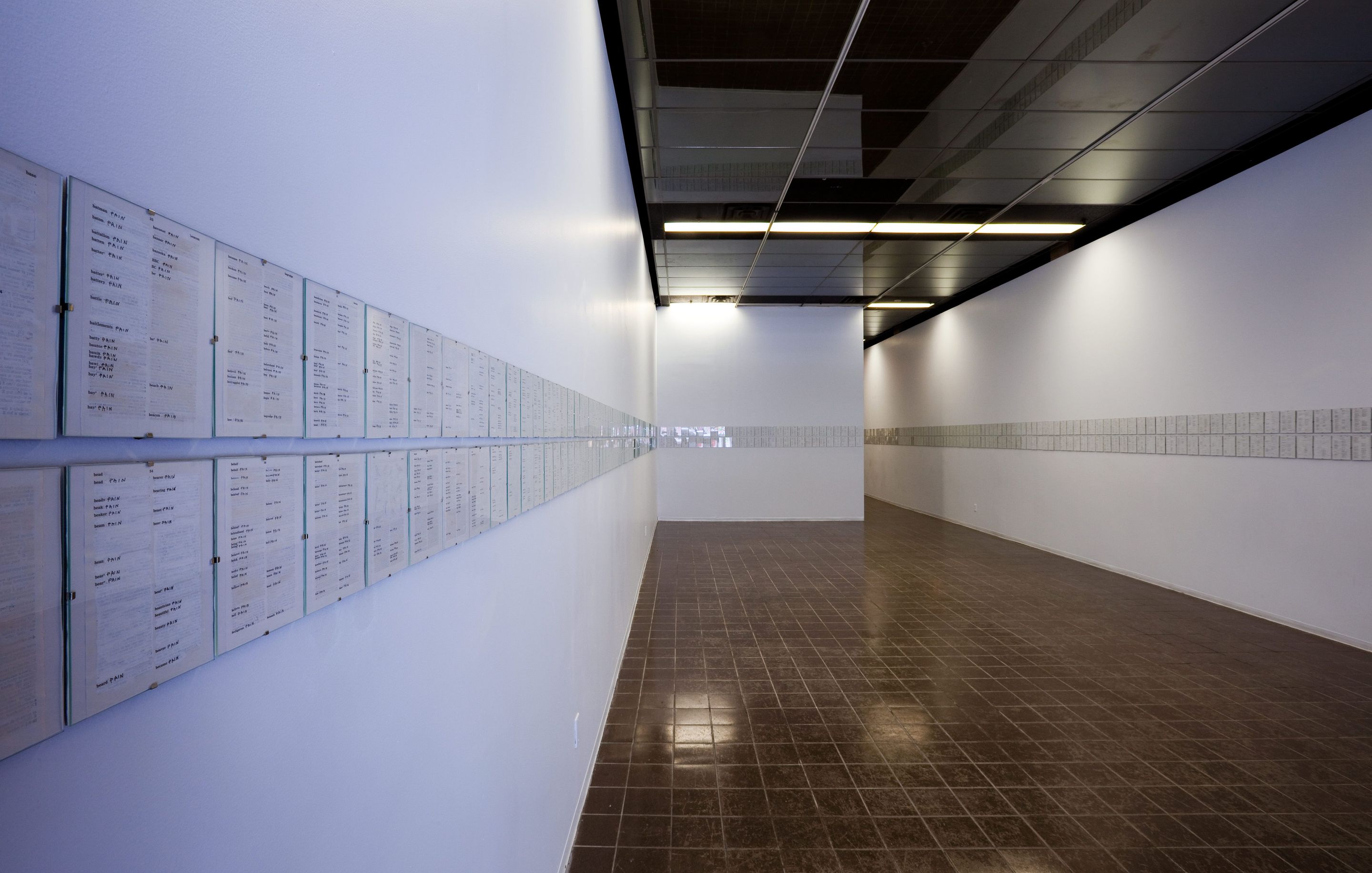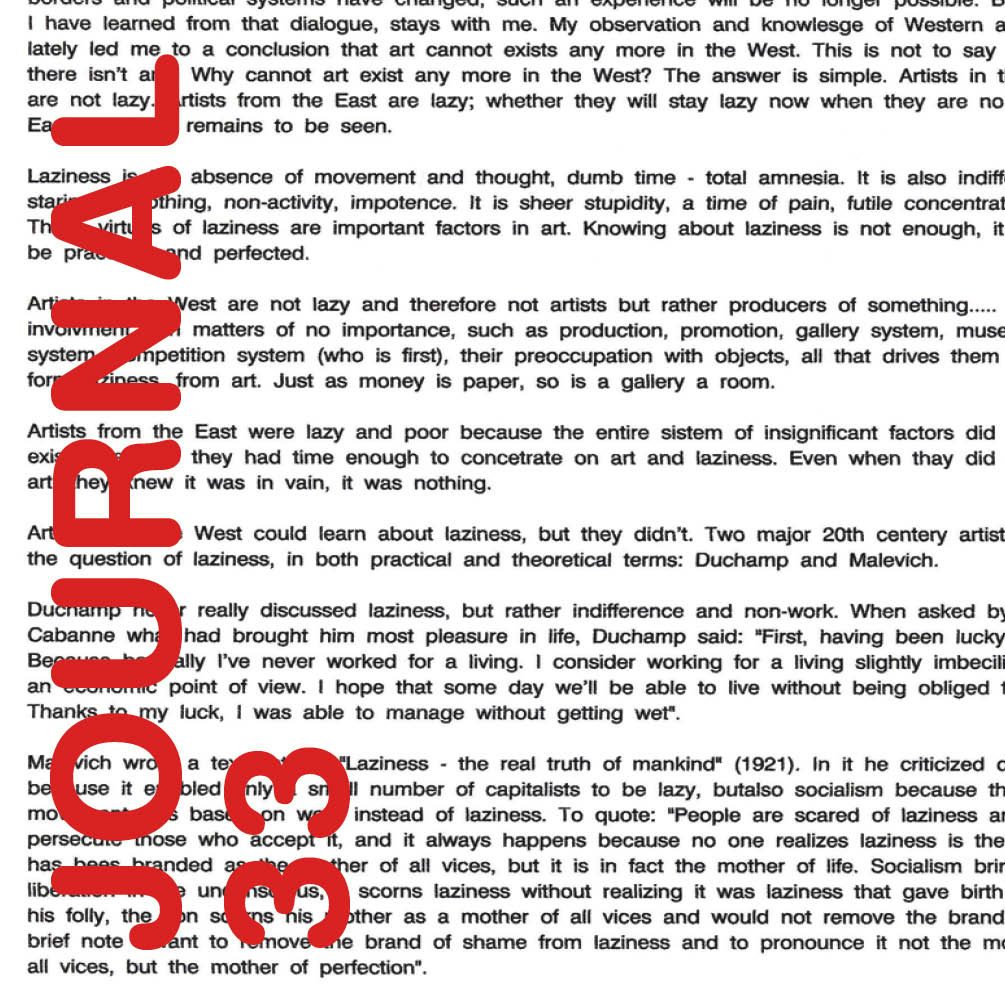
Mladen Stilinović
2010.05.08 - 06.12
Idler // Mladen Stilinović // An Artist Who Invents Nothing
Mladen Stilinović invents nothing. He prefers performing idleness to the ambition of creation and artistic professionalism. Where in his love letter, Stilinović tells art to go and hide, the better to exist freely, in The Praise of Laziness, he asserts that there is no art without laziness. Through a process of mental decompartmentalization, denial of the obvious and rejection of established norms, Stilinović invites us to envision art according to other modes of presentation and consider it outside the boxes of productivity, performance, mercantilism and success. This artist, for whom art is not to be discovered not so much in a realized work or in a finished production, challenges conceptions of art as making and connects it more to a way of being in the world. Born in Belgrade in 1947, Stilinović settled in Zagreb in the 1960s. He is associated with Yugoslavian Conceptual art, having played a prominent role in the movement beginning in the 1970s. He is the author of a complex, demanding body of work that merges text and symbols, subverting the verbal and visual clichés of everyday life that constituted the most potent expression of ideology in the Socialist era. In 1975, he became a member of the Group of Six Artists, which organized exhibition-actions in the street, and in the 1980s collaborated on the project Retro-Avant-Garde with the Slovenian collective IRWIN. In the years since the collapse of Federal Yugoslavia, his work has cast an ironic, paradoxical gaze on such dominant contemporary myths as money, time, work, language and power. Stilinović’s works have been shown in private homes as well as in institutional settings including Galerija Miroslav Kraljevic, Zagreb (2009); Index – The Swedish Contemporary Art Foundation, Stockholm (2009); the Walker Art Center, Minneapolis (2009); the 11th International Istanbul Biennial (2009); the Stedelijk Van Abbemuseum, Eindhoven (2008); Documenta 12, Kassel (2007); MSU – Museum of Contemporary Art, Zagreb (2006); MUMOK – Museum Moderner Kunst Stiftung Ludwig, Vienna; the Ludwig Museum – Museum of Contemporary Art, Budapest (2005); and the Venice Biennale (2003 and 1995).

Excerpt from a conversation between Mladen Stilinović and Ariane Daoust, Zagreb, June 2009
Ariane Daoust: Are you lazy?
Mladen Stilinović: Yes!
AD: Did you become an artist so that you would have complete freedom to practice laziness? Is your project Artist at Work (1978) a critique of the artist’s role in society, and a demystification of the idea of so-called artistic professionalism?
MS: I have never had any strategy or decided intention when it came to my activity as an artist. I see artistic activity as “free shifting.” It’s about the freedom to move in all the directions that may interest me; the freedom of movement in art and life.
AD: Laziness, a recurrent theme in your work, is paradoxically, an active idleness and a positive way of being, a “yes” to life. In this regard, you have said that you are “an absurd nihilist of sorts, but not a pessimist.”
MS: Yes, exactly. It’s a way of being that gives importance to laziness and to the right to exist, simply as a being.
AD: Do you think that artists are fundamentally lazy, and that practicing idleness is precisely the freedom of movement that is inherent in art?
MS: Yes, but it’s different in the West. Artists there aren’t lazy. They are incredibly busy producing, bringing in money, networking, and so forth. An artist can be busy, but that doesn’t necessarily mean he is not a good artist. . . or maybe it does, in a sense. Because an artist who is very occupied, and successful, has to produce a lot, so he’s going to produce a lot of shit. Therefore, he can’t be considered an artist in the sense that laziness is essential to him.
AD: By that, do you mean that art has nothing to do with producing work?
MS: Of course. [. . .] You know, there are so many people who disregard Marcel Duchamp simply because their goal is to produce art and they want to be considered producers of works of art.
AD: Your activity as an artist consists in de-symbolizing signs, so as to empty them of all their ideological density—to make them lazy, if you will. In that sense, can we say that your activity is more decreative than creative?
MS: Yes. Decreation works by an intensive analysis of things. The idea is to rethink images, signs, the street, ideologies and all the rest to find the truth hiding behind them. At that point I understand that they simply are what they are. Nothing more, with no ideology. The problem is that art is laden with too many words, too many stories. I prefer simple stories and it still seems to me that what is important is less and less not more and more.
AD: What do you mean when you say that art is “nothing”?
MS: It’s a tricky question. First of all, it’s a question of culture, in which experts grant themselves the privilege of deciding what is art and what isn’t. But art can also exist elsewhere, without being considered as such. In those cases, art is nothing.
Art is also nothing because it is an activity without end, without a goal. It is very important to understand the “nothing” not in a pessimistic way, but rather as a manifestation of freedom. Freedom in the sense of art. If we don’t see art as being nothing, it becomes ideological, and that makes no sense.
AD: Tell me about your love letter, where you tell art that it should hide in order to remain free. Why? And how would hidden art be embodied?
MS: I don’t know how it can be embodied. Through life, maybe. I have a lot of artist colleagues and friends who practice art simply by making gestures or taking actions without documenting anything. This non-documented art allows one to be completely free of obligations—and, of course, it’s also a particular way of thinking about production.
AD: You enjoy positing and exacerbating paradoxes. Where does that come from? Do you think that something can emerge from paradoxes?
MS: Absolutely. It’s a way of freeing myself of all possible constraints and being completely at liberty to change my stance. I want to have fun.
AD: You make a distinction between your practice and that of Western Conceptual art. Boris Groys has coined the term “Romantic Conceptualism” to describe this kind of art in your part of the world. What do you think of it?
MS: It’s just another approach to art. Conceptual art in the West references reason and philosophy, whereas here it also references literature, poetry, everyday language, emotions and many other things besides. This difference is cultural, and is explained by a different attitude or state of mind. You can’t say that Conceptual art pertains to the Romantic spirit or to poetry in the West. In fact, these words are hated because Conceptual artists are cold, rigid and innocent.
AD: In your opinion, can art emerge from error, since etymologically, the Latin errare means wandering, or freedom of movement?
MS: Absolutely. From error and from stupidity as well. Yet, stupidly, artists are so intent on being smart that they’re afraid of being stupid.